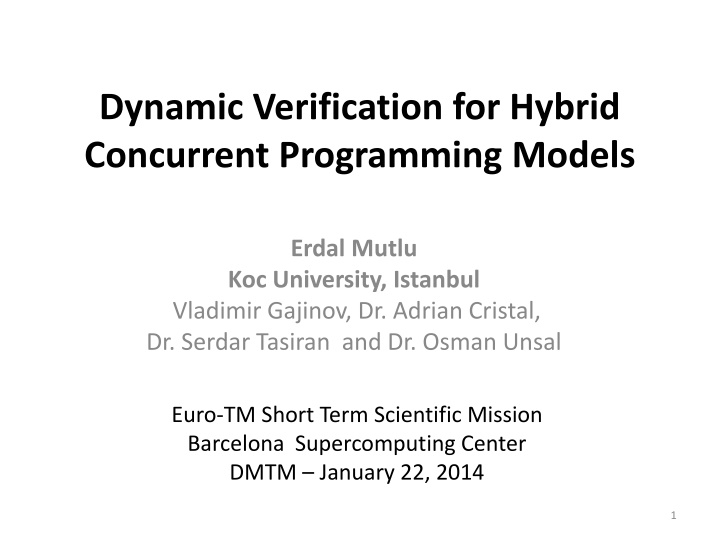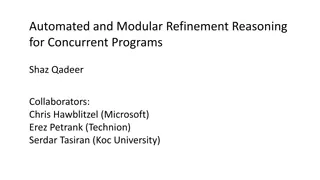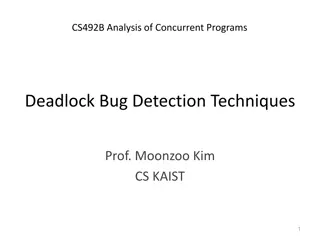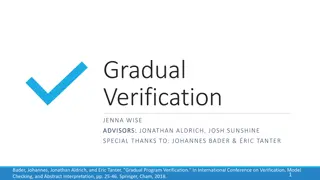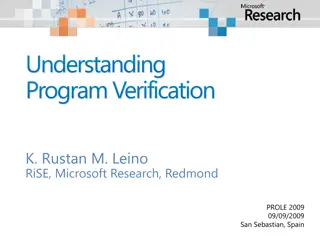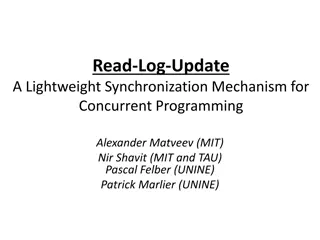Dynamic Verification for Hybrid Concurrent Programming Models
This content discusses dynamic verification for hybrid concurrent programming models, focusing on shared memory, transactional memory, message-passing, and data-flow models. It explores the motivation, proposed solutions, and ongoing work in this field. The importance of testing and verification in the face of emerging concurrency bugs is highlighted through motivating examples. Techniques such as behavior exploration and probabilistic concurrency testing are also covered to address the challenges of ensuring system reliability in concurrent environments.
Download Presentation

Please find below an Image/Link to download the presentation.
The content on the website is provided AS IS for your information and personal use only. It may not be sold, licensed, or shared on other websites without obtaining consent from the author.If you encounter any issues during the download, it is possible that the publisher has removed the file from their server.
You are allowed to download the files provided on this website for personal or commercial use, subject to the condition that they are used lawfully. All files are the property of their respective owners.
The content on the website is provided AS IS for your information and personal use only. It may not be sold, licensed, or shared on other websites without obtaining consent from the author.
E N D
Presentation Transcript
Dynamic Verification for Hybrid Concurrent Programming Models Erdal Mutlu Koc University, Istanbul Vladimir Gajinov, Dr. Adrian Cristal, Dr. Serdar Tasiran and Dr. Osman Unsal Euro-TM Short Term Scientific Mission Barcelona Supercomputing Center DMTM January 22, 2014 1
Outline Hybrid concurrent programming models Motivation Dynamic verification Our proposed solution Conclusion Ongoing Work 2
Hybrid Concurrent Programming Models Concurrent programming models Shared memory: Lock based, Transactional Memory Message-passing Data-flow Hybrid concurrent programming models Data-flow + Shared memory Atomic DataFlow (ADF) programming model OpenMP 4.0 Intel TBB-Flow graph 3
Atomic DataFlow (ADF) Programming Model Data-flow constructs with Transactional Memory (TM) support 4
Motivation New programming models give rise to new kinds of concurrency bugs Combination of models Programmer visible non-determinism Verification/Testing capabilities are required 5
Motivating Example Consider two tasks: max_min: compute the maximum and minimum values from two input streams while updating a global min and max comp_avg: comparing the average values of global max and min with the input values and returning the bigger one. 6
Motivating Example Read old value 7
Dynamic Verification for Concurrent Systems Behavior Exploration Randomized Exploration Probabilistic Concurreny Testing (PCT) Disciplined randomization of thread schedules Probabilistic guarantees Systematic Exploration CHESS Systematically enumerating thread interleavings Reliably reproducing concurrent executions 8
Probabilistic Concurrency Testing (PCT) Bug Depth: the number of ordering constraints a schedule has to satisfy to find the bug Finds concurrency bugs in every run of the program With reasonably-high probability Scalable In the no. of threads and program size Effective Bugs in IE, Firefox, Office Communicator, Outlook, Bugs found in the first few runs 9
Dynamic Verification for Hybrid Systems Current verification techniques lack: Knowledge about different models Transactional memory (TM) Dataflow Programmer visible non-determinism We propose: Randomized exploration for hybrid programming model Invariant monitoring mechanism 10
Randomized Behavior Exploration for ADF Priority based scheduling Assign random priorities to enabled tasks Priority change points Assign random priority change points before and after atomic blocks Schedule tasks by honoring priorities Check invariants at each step of execution 11
Randomized Exploration for ADF P:3 P:4 P:4 max_min2 max_min2 max_min1 1. 2. Assign priorities (1-N) Assign priority change point (depth = 1) Schedule task honoring priorities Run max_min2 to completion and enable comp_avgtasks Assign new priorities Run max_min1 until priority change point Run comp_avg1 z1 = max(x,y); z1 = max(x,y); z2 = min(x,y); z1 = max(x,y); z2 = min(x,y); z2 = min(x,y); atomic{ if(z1>g_max) g_max = z1; atomic{ if(z1>g_max) g_max = z1; } atomic{ if(z1>g_max) g_max = z1; } } 3. P : 0 //do local updates //do local updates //do local updates 4. atomic{ if(z2<g_min) g_min = z2; atomic{ if(z2<g_min) g_min = z2; } atomic{ if(z2<g_min) g_min = z2; } } P:1 P:2 5. 6. comp_avg1 comp_avg1 comp_avg2 comp_avg2 avg1 = avg(z1,z2); avg1 = avg(z1,z2); avg2 = avg(g_max,g_min); avg2 = avg(g_max,g_min); Read old value avg1 = avg(z1,z2); avg1 = avg(z1,z2); avg2 = avg(g_max,g_min); avg2 = avg(g_max,g_min); if(avg1 > avg2) res = avg1; else res = avg2; res = avg2; if(avg1 > avg2) res = avg1; else if(avg1 > avg2) res = avg1; else res = avg2; res = avg2; if(avg1 > avg2) res = avg1; else 7. 12
Conclusion New hybrid programming models new kinds of races We proposed: Randomized testing capabilities with probabilistic guarantees Invariant monitoring mechanism 13
Ongoing Work Evaluation Dwarf benchmarks Game engine Probabilistic guarantee analysis Record and replay capabilities 14
Thank you! Questions? 15
